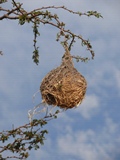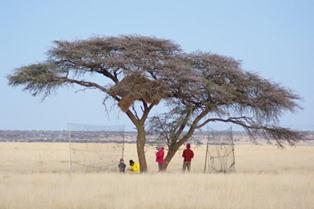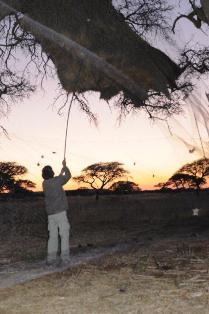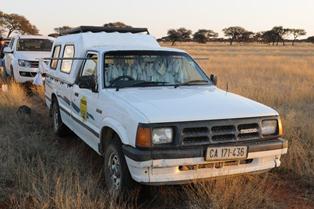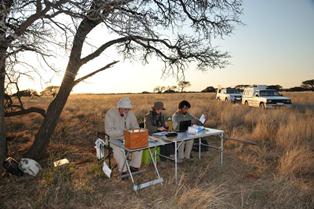Sociable Weaver demography, 2012-2016
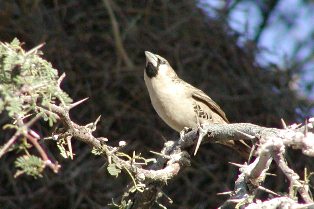
This is a new project for teams of ringers to make an important contribution to studying the population dynamics of the Sociable Weaver Philetairus socius, a cooperative breeder restricted to arid and semi-arid regions of southern Africa. This species could show large range changes in future decades due to climate change. Ringers can help track these changes by ringing at selected colonies on an annual basis to obtain survival and breeding productivity data, combined with counting nest chambers to provide nest size data.
Aims
Our aim is to understand the population ecology of Sociable Weavers, i.e. what makes colonies grow and what makes them decline. And we would like to get this understanding for a number of colonies in different parts of the species range. This will help us anticipate likely effects of climate change on these birds and to use them as indicators for change in arid regions of southern Africa.Team leaders:
Dieter Oschadleus - bird ringing coordinator, PHOWN coordinator - SAFRING, ADU, UCT
Res Altwegg - statistical ecologist - SANBI & ADU
Rita Covas - Sociable Weaver specialist, Fitz, UCT
To become involved
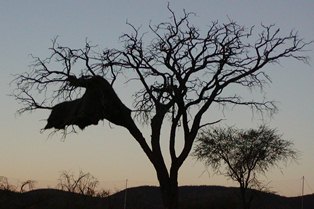
- Get a team of committed ringers.
- Decide on a Sociable Weaver site - either one you know of, or ask for ideas, eg private farm, or nature reserve, and can include colonies on telephone poles or other man-made sites.
- Decide on 2-5 colonies to target annually - if you have a week, then you can ring at least 5 colonies; if you have a weekend to commit to the project you can ring at 2 colonies.
- Budget time: 1 week or weekend every August for the next 5 years.
- Budget costs for travel and accommodation.
- Read the research protocol below - it is strict and needs to be adhered to for the data to be valuable for analysis.
- Organise permission from the land-owner, and obtain permits from Namibia, Botswana, Northern Cape or North-west Province.
- Register your team names and site details by emailing Dieter.
Research protocol
Ringing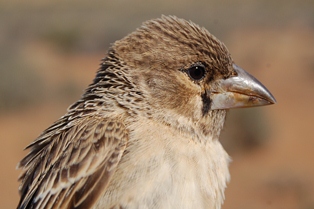
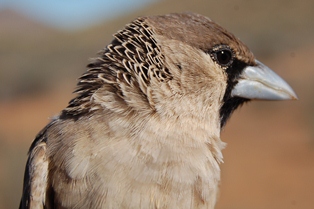
- Ring at each of 2-5 colonies at your site for the next 5 years, starting August 2012.
- Each colony should be ringed any time during August - this month is critical to standardisation in the project.
- Each colony must only be ringed once, ie no ringing here during the rest of the year, to reduce disturbance.
- The ringing data needs to be submitted to SAFRING during September.
- A detailed catching and ringing protocol is below.
The ringing data will provide colony size (number of adults), previous breeding effort (number of juveniles present). Recaptures (after the first year) will provide survival data.
Detailed Capture Protocol, by Rita Covas
Time of yearThe captures should take place during August and each colony should only be captured once a year.Mist-nets and capture procedureBirds are captured with mist nets placed around the nesting tree before dawn. This is usually best achieved by placing 2-3 mistnest around the tree (or colony, depending on the shape and size of the tree and branches). Some photos are given as example below. Photo (right): mistneting in winter, Cyril DuthecWhen to put up netsIt might be tempting to put up the nets the night before, and keep them folded overnight, to facilitate the work in the morning. At Benfontein Game Reserve, where these weavers have been studied for several years, we have noticed that the birds avoid roosting in the nest if there is obvious activity in place at dusk. However, in Namibia, ringers have put nets up the evening before with no apparent avoidance by the occupants. A mixed strategy is probably ideal, where the location of poles and nets is decided the day before - and when steel anchor pins are used (which requiring audible hammering), these are also put in place the night before, but the nets are only placed in the morning. If everything is done in the morning it can take up to 1h (depending on experience and number of nets used). If pins and poles are in place it should take less then 1/2 hour. We have also noticed that the use of red headlamp beams causes less disturbance than the normal white ones when erecting nets in the dark.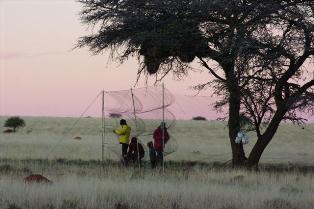
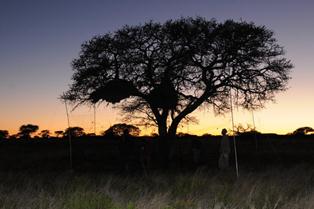
Photos: mistnets around tree, Cyril Duthec
Flushing the birdsThere should be an open side from which the ringers will enter to flush the birds. About 15 min before sunrise the group carefully and silently approaches from the open side and flushes the birds into the nets by suddenly making noise (clapping hands, shouting). Avoid going under the nest initially as some birds hide inside and may fly out in the opposite direction. It is best to use a pole to gently touch the nest mass to encourage any additional birds to come out. The moment when flushing the birds is important: if too early (too dark) many birds will hide in the nest; if too late they will probably come out and fly away when they hear people approaching the nest.Photo (right): pole poking nest, Res Altwegg Placing the netsThe nets should be placed on the outside and below the colonies. You will notice that when flushed the weavers will drop straight down from the chambers, so the nets need to be placed fairly low, otherwise many birds will escape by flying under the nets. This can be counter-intuitive, but unless the colonies are fairly high (above 4m), the nets should almost touch the ground (see photos for examples). However, if the nets are placed fairly close to the colony (ca 0.5m) then they can be a bit higher, as they will catch the weavers before they drop all the way down. A second, higher ring of nets can be used behind the low first ring to increase capture success.Estimating colony sizeA small number of birds usually manages to escape (by flying over the nets) - it is very important to count this as best as possible since these can be added to the total number of birds caught, thereby providing a good estimation of colony size.In addition, if possible, count the number of chambers in the colony caught. This can be difficult for large colonies, but several counts by different observers will nonetheless produce useful estimations. Some chambers get abandoned - these usually have wide, 'untidy' entrances, or even cob web and should not be included in the count. Extracting birdsBirds should be quickly removed from the nets by experienced ringers only. Remember that some colonies are extremely large (up to a few hundred birds) and all those birds will fall in the nets simultaneously! Large colonies should only be tackled by an adequate number of ringers. Please visit the colony before to have an idea of how many birds to expect. If the birds are away, a rough indication is given by the number of chambers - you can expect approximately twice as many birds (though there will be surprises in both directions). Also be sure you have enough linen bags.Closing the netsAfter extracting the last bird the nets should be closed. If they are left open they will catch some released weavers as well as other errant birds. This will increase disturbance for the weavers and increase overall handling times, which should be avoided in order to keep the study disturbance to the minimum possible.
ProcessingIn August the temperatures in the morning can drop to several degrees below zero. These weavers are extremely sensitive to low temperatures and should be kept warm until processed and released. One option is to leave them in the car, facing the sun as in the photo.Photo: weavers hanging in bags inside the bakkie, Res Altwegg By-catchYou will most likely catch other species that roost in the weavers' nest mass. Processing the weavers should take priority over these other species to minimise disturbance to the weavers, as the study species here. However, some species, such as Ashy Tits are sensitive to delayed processing. Good sense should therefore be used to evaluate the numbers of Sociable Weaver and other species caught and decide when other species should be processed before the weavers.Please take note of the number of other species caught (i.e. how many birds of which species) as this may also be useful. Data to recordPlease record for all colonies captured:o Colony size (number of birds caught + number of birds escaped - please indicate both) o Time when the colony was flushed, time when the birds were extracted from the nets, time the last bird was released For individual birds: Large colonies will take a long time to process, so it might not be feasible to collect all the data below for all colonies. Ideally, the whole process from flushing the birds to releasing the last one should not take longer than 2h-2.5h, although this might be difficult for some very large colonies (again, these should only be attempted with a large number of ringers). If time is pressing, the most important data to collect for this project are the first four points below. If there is enough time, then the rest can also be done. Please make a note of any injuries or other problems you may notice.
Photo: processing, Anne Delestrade Note: colour rings should not be used unless the individuals are part of another study that specifically requires these rings. |
Nest counts
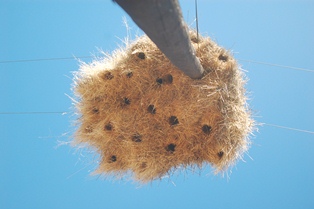
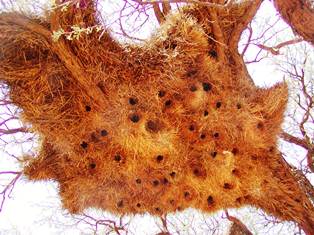
- The nest chambers in each study colony need to be counted during the study period.
- Tips on counting chambers in large colonies will be posted here later.
- Colony records need to be submitted to PHOWN every year, to be submitted during September.
- Highly recommended option - submit PHOWN records for all surrounding colonies.
The PHOWN data will provide photos, nest size, point locality and other colony details.
Summary results
Registered sites will be shown here (by Aug 2012).Summaries will be posted here (from Sept 2012), showing data collection progress.

Vm 31396
To see all PHOWN records for the Sociable Weaver, see here
News items relating to this project
Latest news item:Sociable Weaver demography project2012-02-01 (183) This is a new project for teams of ringers to make an important contribution to studying the population dynamics of the Sociable Weaver Philetairus socius, a cooperative breeder restricted to arid and semi-arid regions of southern Africa. This species could show large range changes in future decades due to climate change. Ringers can help track these changes by ringing at selected colonies on an annual basis to obtain survival and breeding productivity data, combined with counting nest chambers to provide nest size data.
This is a new project for teams of ringers to make an important contribution to studying the population dynamics of the Sociable Weaver Philetairus socius, a cooperative breeder restricted to arid and semi-arid regions of southern Africa. This species could show large range changes in future decades due to climate change. Ringers can help track these changes by ringing at selected colonies on an annual basis to obtain survival and breeding productivity data, combined with counting nest chambers to provide nest size data.
Thus this project will link data collected by citizen scientists for SAFRING and PHOWN. This project will run for at least 5 years, starting in August 2012. Read the project protocol here. |
All news items relating to this project
The headers below refer to Weaver News items featuring PHOWN. Click on a header to see the News item, which includes the full news item. (The number in brackets is the date that the news item appeared on Weaver Watch).
Sociable Weaver demography project (2012-02-01)








